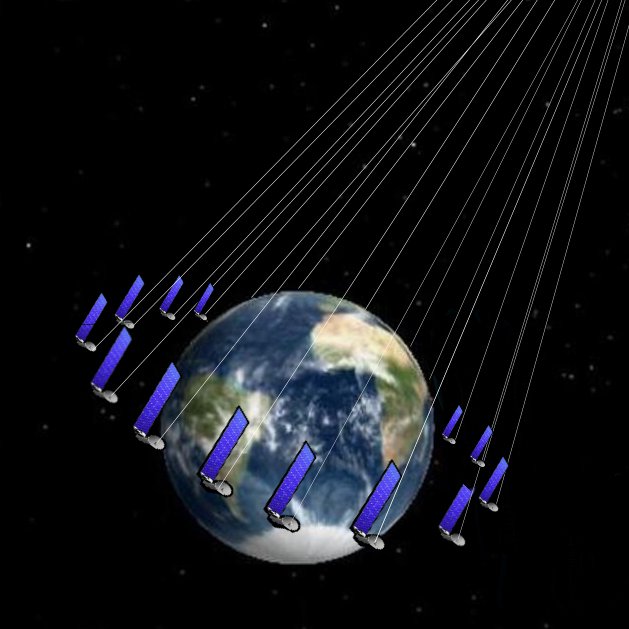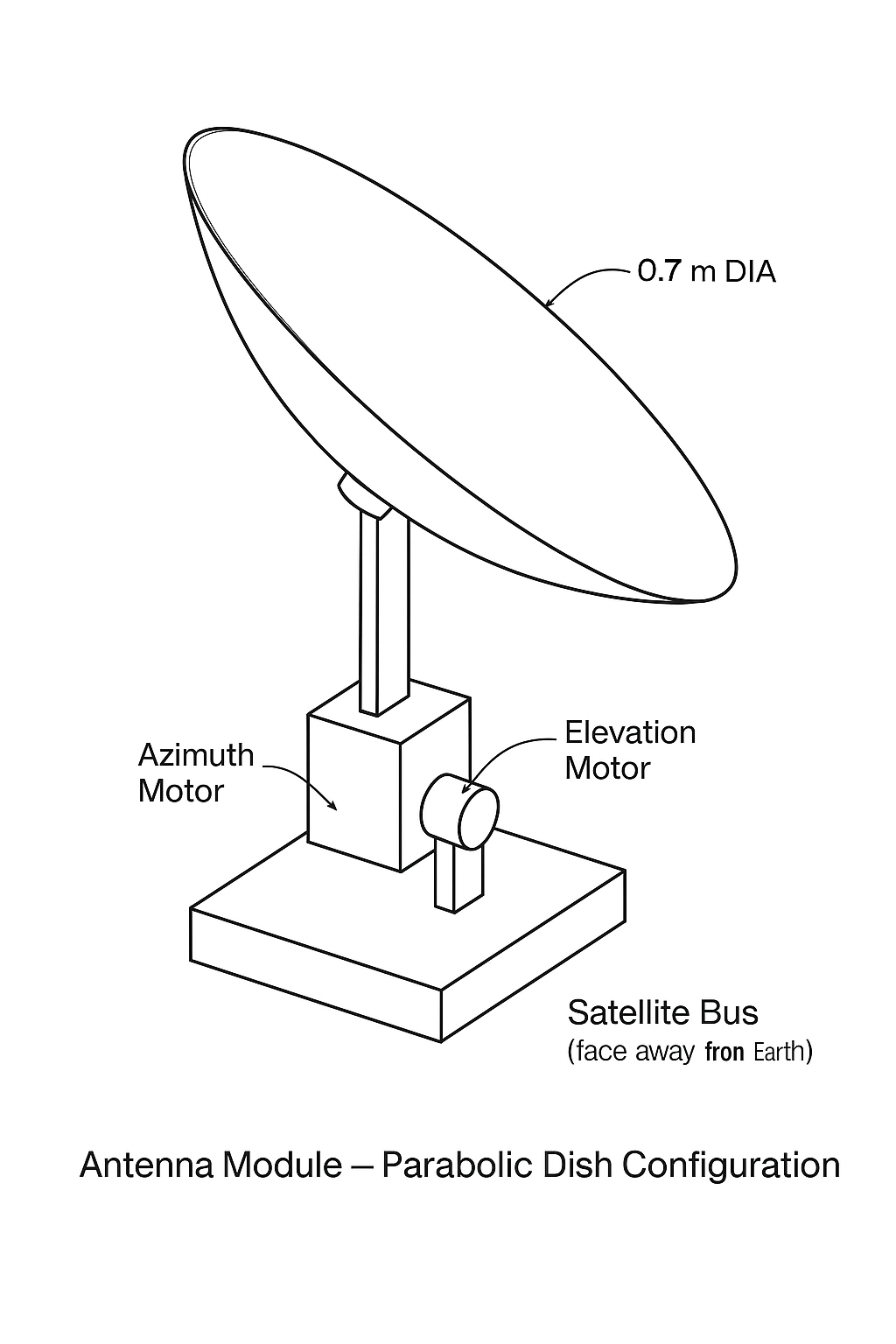Distributed Radio Astronomy Using Future Skylink Satellites.
McGary Array for Distributed Radio Astronomy (McGADRA)
A Proposal for Distributed Radio Astronomy Using Future Skylink Satellites
1. Executive Summary
The McGary Array for Distributed Radio Astronomy (McGADRA) proposes equipping each future Skylink satellite with a small, steerable radio dish antenna facing outward into deep space. By linking these antennas via inter-satellite communication and synchronized timing, McGADRA will form a large, flexible, space-based radio interferometer with resolution and sky coverage unmatched by Earth-bound arrays.
Leveraging the Skylink constellation’s extensive satellite network minimizes deployment costs while offering a powerful new scientific instrument capable of transformational advances in astrophysics, space weather monitoring, and Earth science. McGADRA’s modular, scalable architecture enables incremental deployment, early science demonstrations, and long-term operation.
Furthermore, McGADRA proposes a commercial time-rental model allowing external research institutions and organizations to lease observation time, generating revenue to offset costs and support sustainable operations.
2. Technical Concept
2.1 Antenna Hardware
The McGADRA system centers on integrating a compact, steerable radio dish antenna onto each Skylink satellite. To balance scientific capability with satellite constraints, the proposed dish diameter ranges from 0.5 to 1 meter, allowing sensitivity across selected frequency bands while minimizing mass and power demands.
The antenna design can take one of two main forms:
Parabolic Dish with Mechanical Steering: A lightweight, gimbaled reflector capable of precise pointing toward deep space targets. Mechanical steering allows wide angular coverage but requires robust motorized mechanisms tolerant of the space environment.
Phased Array Antenna: An electronically steerable array with no moving parts, offering rapid beam direction changes and improved reliability at the expense of increased complexity and power usage.
McGADRA prioritizes frequency bands in the L-band (1.4 GHz) through C-band (4–8 GHz) range, enabling studies of key astrophysical phenomena such as neutral hydrogen lines and pulsar emissions. The specific frequency selection will be refined during detailed design, informed by scientific priorities and regulatory considerations.
2.2 Satellite Integration
The antenna module will be mounted on the side of each satellite facing away from Earth to minimize interference from ground-based transmissions and maximize exposure to deep space radio sources. Integration considerations include:
Structural attachment compatible with the existing Skylink satellite bus.
Power supply and thermal management subsystems tailored for antenna electronics.
Minimal impact on satellite mass, volume, and aerodynamic profile.
2.3 Array Formation and Control
McGADRA’s scientific power derives from coherently combining signals from antennas distributed across the Skylink constellation. This requires:
Precise satellite attitude control to maintain antenna pointing and stable baseline geometries.
High-accuracy timing synchronization using onboard atomic clocks or GPS-disciplined oscillators to align signal phases for interferometry.
Dynamic reconfiguration of the array geometry through electronic or mechanical steering of antennas and minor orbital adjustments.
2.4 Data Handling and Processing
The system architecture incorporates:
High-speed inter-satellite communication links to share digitized radio data.
Onboard signal preprocessing (e.g., beamforming, filtering) to reduce raw data volume.
Ground station infrastructure to receive correlated data streams, perform final signal correlation, imaging, and scientific analysis.
3. Science & Applications
The McGary Array for Distributed Radio Astronomy (McGADRA) promises to open new frontiers in astrophysical research and space environment monitoring by harnessing the combined power of a large, distributed radio telescope in orbit. Its unique configuration offers several key scientific and practical advantages:
3.1 Astrophysical Research
High-Resolution Imaging: By forming long baselines between widely separated Skylink satellites, McGADRA can achieve angular resolutions far exceeding those of Earth-based radio telescopes, enabling detailed imaging of distant cosmic phenomena such as pulsars, active galactic nuclei, and black hole event horizons.
Transient Phenomena Detection: Continuous, all-sky coverage allows McGADRA to detect and localize transient radio events like fast radio bursts (FRBs), solar flares, and magnetar outbursts with unprecedented precision and rapid response capability.
Neutral Hydrogen Studies: Observations at the 1.42 GHz hydrogen line enable mapping of the large-scale structure of the universe, interstellar medium dynamics, and star formation regions without atmospheric interference.
Cosmic Microwave Background (CMB) and Polarization: Measurements at suitable frequency bands can contribute to understanding the early universe through CMB anisotropies and polarization studies.
3.2 Space Weather and Earth Monitoring
Solar and Geomagnetic Monitoring: McGADRA’s vantage point in orbit provides an ideal platform to monitor solar radio bursts and geomagnetic disturbances, supporting space weather forecasting and protection of Earth’s technological infrastructure.
Atmospheric and Ionospheric Science: By analyzing radio signal perturbations, the array can contribute to studying Earth’s ionosphere and upper atmosphere dynamics.
3.3 Communication Network Synergies
Noise Reduction and Signal Validation: McGADRA’s scientific antennas can assist Skylink’s communications payload by providing spatial filtering and noise characterization, improving signal quality and network robustness.
Dual-Use Infrastructure: Leveraging the Skylink constellation’s existing power, data links, and attitude control reduces costs and enables rapid deployment of scientific capabilities.
3.4 Search for Extraterrestrial Intelligence (SETI)
Enhanced Sensitivity and Sky Coverage: The distributed array’s high sensitivity and continuous coverage make McGADRA an ideal platform for SETI programs aiming to detect faint or transient extraterrestrial radio signals.
4. Engineering Challenges & Solutions
While McGADRA offers a compelling scientific vision, realizing it requires addressing several technical challenges:
4.1 Baseline Stability and Formation Control
Maintaining stable, known relative positions between satellites is critical for coherent interferometry. Small orbital perturbations must be monitored and compensated using:
Precision attitude control systems on each satellite.
Potential micro-thrusters for fine orbital adjustments.
Real-time telemetry and formation-keeping algorithms.
4.2 Timing Synchronization
Phase-coherent signal combination demands sub-nanosecond timing precision across the array. Solutions include:
Deploying compact onboard atomic clocks.
Synchronization via GPS signals or dedicated inter-satellite timing links.
Periodic calibration using known celestial sources.
4.3 Data Bandwidth and Processing
Transmitting raw radio data from multiple satellites to Earth requires vast bandwidth. McGADRA mitigates this through:
Onboard preprocessing such as digitization, filtering, and partial beamforming.
Compression algorithms tailored for radio astronomy data.
Leveraging Skylink’s high-throughput inter-satellite data network.
4.4 Antenna Pointing and Reliability
Antennas must sustain accurate pointing over the mission lifetime while enduring:
Thermal cycling and space radiation.
Mechanical wear (for dishes with moving parts).
Vibration during launch.
Robust materials, radiation-hardened electronics, and redundancy in steering mechanisms will be implemented.
4.5 Payload Constraints
Each dish module must minimize:
Additional mass and volume to avoid compromising Skylink satellite performance.
Power consumption to fit within existing satellite energy budgets.
Modular, lightweight designs using advanced composites and low-power electronics are proposed.
5. Implementation Roadmap
McGADRA deployment is envisioned in three major phases:
Phase 1: Concept Development and Prototyping (Year 1–2)
Detailed design and simulation of antenna modules.
Laboratory testing of prototypes under space-like conditions.
Development of timing synchronization and data handling software.
Phase 2: Flight Demonstration (Year 3)
Integration of antenna modules on a limited number of Skylink satellites as experimental payloads.
In-orbit validation of antenna pointing, timing, and inter-satellite communication.
Initial science observations to verify performance.
Phase 3: Full Deployment and Operations (Year 4+)
Equipping all new Skylink satellites with McGADRA antenna modules.
Ground infrastructure upgrades for data processing and archiving.
Establishment of regular science observation campaigns and public data release protocols.
6. Cost and Resource Estimates
Preliminary cost estimates for McGADRA include:
Antenna Module Production: Approximately $100,000 to $150,000 per unit, including materials, assembly, and testing.
Satellite Integration: Minor additional integration costs estimated at $20,000 per satellite.
Launch Impact: Negligible, given low mass (~5–10 kg) and compact size.
Ground Infrastructure: Estimated $5 million initial investment for processing hardware and software development.
Operations: Annual budget for data analysis, calibration, and maintenance estimated at $1 million.
These estimates will be refined during the Phase 1 feasibility study.
7. Benefits and Strategic Impact
McGADRA represents a pioneering synergy between commercial satellite constellations and scientific discovery. Key benefits include:
Scientific Leadership: Establishing new benchmarks in space-based radio astronomy with unprecedented resolution and sky coverage.
Cost Efficiency: Utilizing existing Skylink infrastructure reduces development and deployment costs compared to dedicated scientific satellites.
Dual-Use Capabilities: Enhancing Skylink’s communication network robustness while serving scientific goals.
Revenue Generation through Time Rental: McGADRA’s flexible array can allocate observing time to universities, research institutions, government agencies, and private companies on a rental basis, creating an ongoing revenue stream to help offset operational costs and fund further development.
International Collaboration: Providing a platform for partnerships with academic institutions, government agencies, and space agencies worldwide.
Public Engagement: Offering public access to unique astrophysical data, inspiring STEM education and outreach.
8. Conclusion and Recommendations
The McGary Array for Distributed Radio Astronomy (McGADRA) is a visionary yet feasible initiative to transform Skylink satellites into a powerful, distributed radio telescope. By integrating steerable radio dishes on each satellite, McGADRA can deliver unmatched astronomical insight, complementing and extending ground-based observatories.
We recommend proceeding immediately with a detailed feasibility study and prototyping phase to refine technical designs, cost models, and science goals. Collaborative partnerships and funding avenues should be explored to realize McGADRA’s full potential.
To support sustainable operations, McGADRA will implement a commercial time-rental model, offering observing slots to external organizations. This approach will generate revenue to recoup costs and enable continuous upgrades, ensuring the array’s long-term viability.
Licensing & Attribution
This white paper and proposal are released under the Creative Commons Attribution-ShareAlike 4.0 International License (CC BY-SA 4.0).
You may share, adapt, and redistribute this work with proper attribution and under identical licensing terms. For details, visit creativecommons.org/licenses/by-sa/4.0.
Technical Appendices for McGary Array for Distributed Radio Astronomy (McGADRA)
Appendix A: Antenna Module Design
A1. Antenna Type Options
Parabolic Dish: 0.5–1 m diameter lightweight aluminum or composite reflector.
Phased Array: Electronically steerable patch array with beamforming electronics.
A2. Mechanical Steering Mechanism (if parabolic dish)
Gimbal assembly with two degrees of freedom (azimuth and elevation).
Stepper motors with microstepping control.
Position sensors and closed-loop control system.
A3. Antenna Placement
Mounted on satellite face opposite Earth-pointing communications.
Deployable boom option for stowed launch configuration.
Appendix B: Timing and Synchronization Systems
B1. Onboard Clocks
Rubidium or chip-scale atomic clocks with drift < 1 ns/day.
GPS-disciplined oscillators for synchronization.
B2. Inter-Satellite Timing Links
Laser or microwave crosslinks with sub-nanosecond timing precision.
Algorithms for real-time delay calibration and phase alignment.
Appendix C: Data Handling and Processing
C1. Data Acquisition
Bandwidth per antenna ~10 MHz – 100 MHz depending on science band.
Analog-to-digital conversion at 8–12 bit resolution.
C2. Data Compression
Lossless or near-lossless compression algorithms tailored for radio astronomy data.
C3. Ground Station Correlator
High-performance FPGA and GPU clusters.
Real-time imaging and transient event detection pipelines.
Appendix D: Sample Design Schematics
D1. Antenna Module – Parabolic Dish Configuration
D2. Phased Array Concept
Rectangular panel of patch antennas (e.g., 32 x 32 elements).
Integrated beamformer electronics on PCB.
Mounted flush on satellite surface.
Appendix E: Power and Thermal Budget Estimates
SubsystemPower ConsumptionThermal DissipationNotesAntenna electronics5–10 WModerateDepends on beamformingSteering motors1–3 W (peak)LowIntermittent useTiming system2–5 WLowContinuous operationData processing10–20 WModerateOnboard preprocessing




